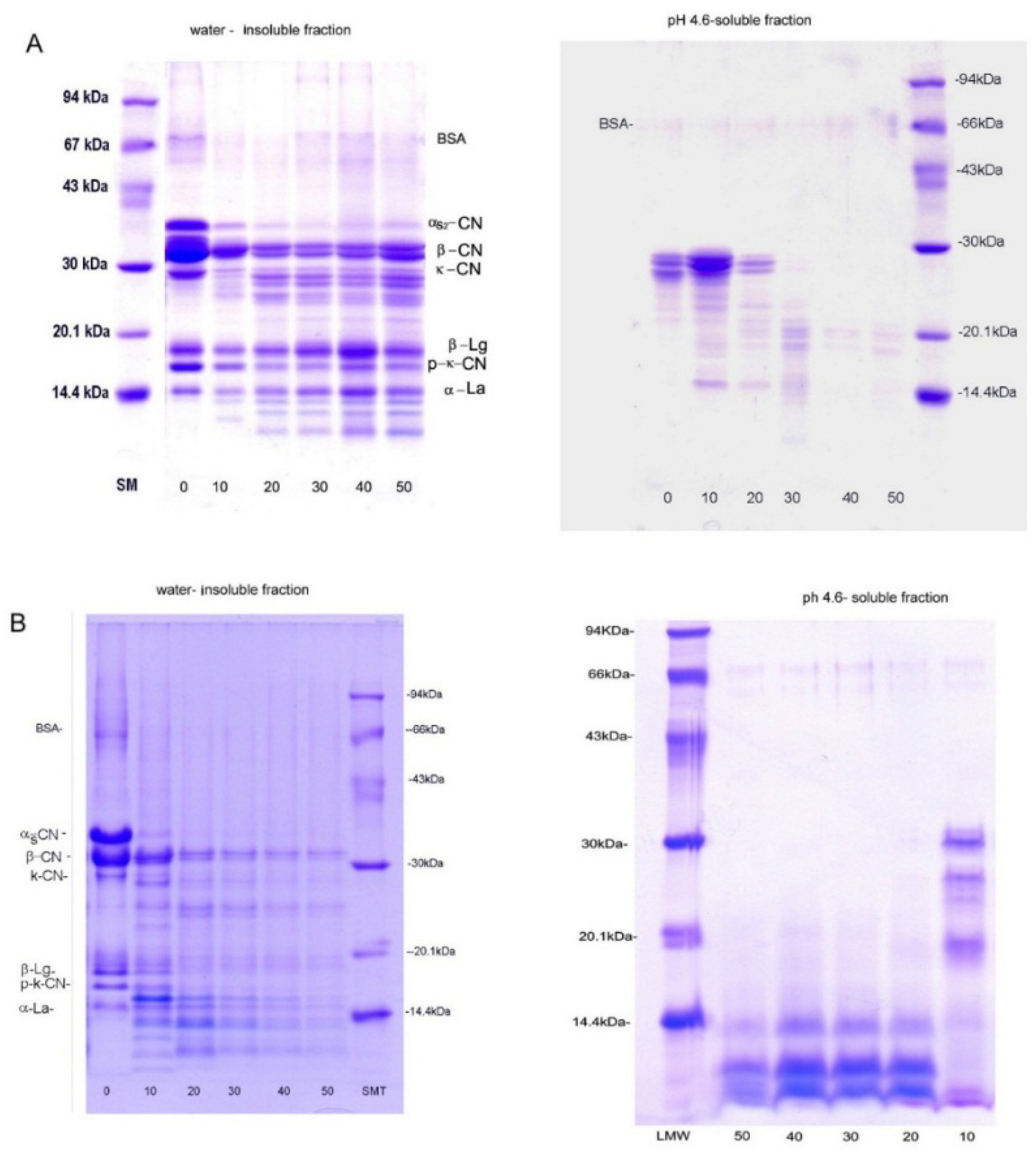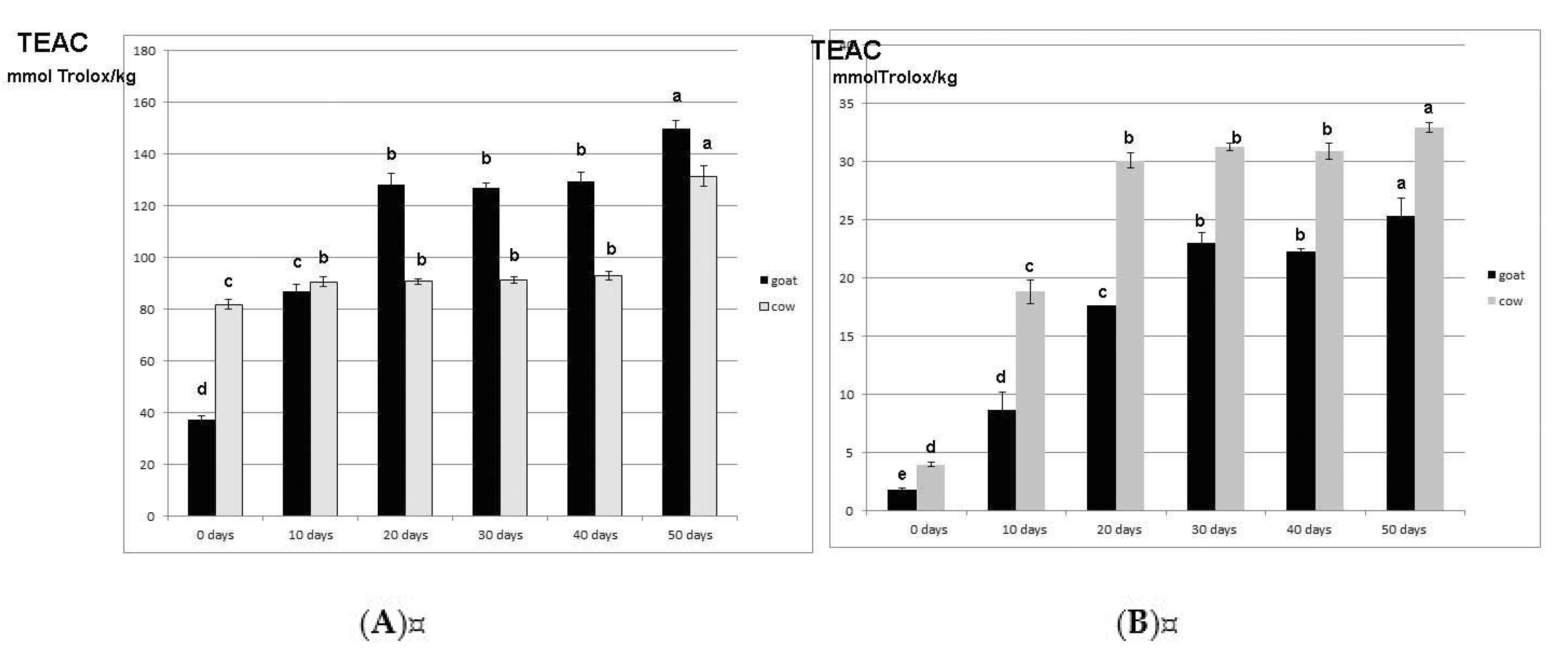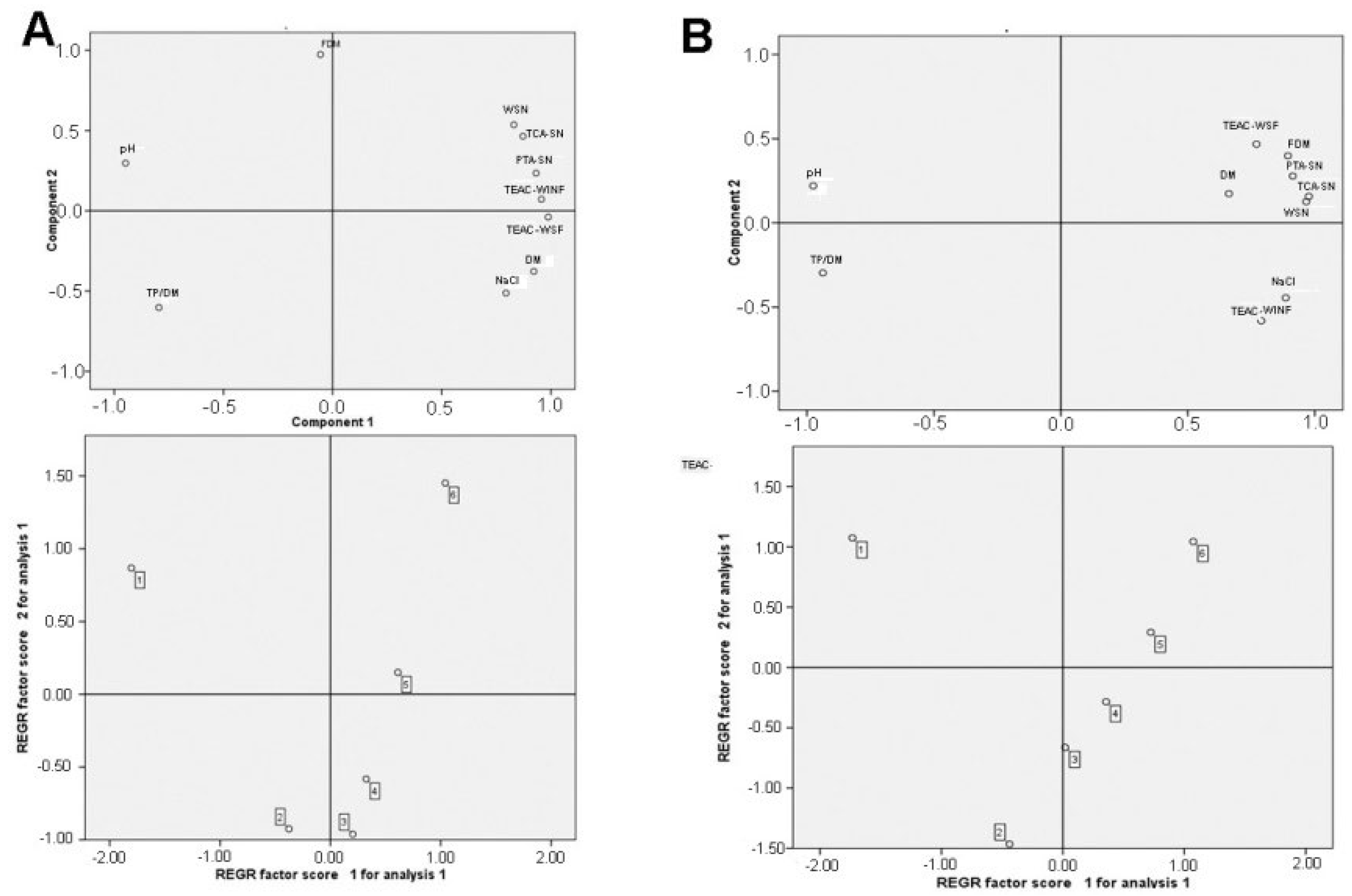The Influence of Milk Type on the Proteolysis and Antioxidant Capacity of White-Brined Cheese Manufactured from High-Heat-Treated Milk Pretreated with Chymosin
Abstract
1. Introduction
2. Materials and Methods
2.1. Cheese Making
2.2. Physicochemical Analyses of Milk and Cheese
2.3. Assessment of Proteolysis
2.4. Antioxidant Properties of Water-Soluble and Water-Insoluble Protein Fractions
2.5. In Vitro Simulated Digestion of Protein Fractions
2.6. Statistical Analysis
3. Results and Discussion
3.1. Compositional Analysis
3.2. Total Proteins, Nitrogen Fractions, and Protein Profiles
3.3. The Change of Antioxidant Properties during Proteolysis
3.4. Principal Component Analysis
4. Conclusions
Author Contributions
Funding
Acknowledgments
Conflicts of Interest
References
- Barac, M.; Pesic, M.; Vucic, T.; Vasic, M.; Smiljanic, M. White cheesesas a potential source of bioactive peptides. Mljekarstvo 2017, 67, 3–15. [Google Scholar] [CrossRef]
- Considine, T.; Patel, H.A.; Anema, S.G.; Singh, H.; Creamer, L.K. Interactions of milk proteins during heat and high hydrostatic pressure treatments—A Review. Innov. Food Sci. Emerg. Technol. 2007, 8, 1–23. [Google Scholar] [CrossRef]
- Chandrapala, J.A.M.A.; McKinnon, I.; Udabage, P. Effects of pH, calcium-complexing agents and milk solids concentration on formation of soluble protein aggregates in heated reconstituted skim milk. Int. Dairy J. 2010, 20, 777–784. [Google Scholar] [CrossRef]
- Chevalier, F.O.; Kelly, A.L. Proteomic quantification of disulfide-linked polymers in raw and heated bovine milk. J. Agric. Food Chem. 2010, 58, 7437–7444. [Google Scholar] [CrossRef]
- Barac, M.; Smiljanic, M.; Zilic, S.; Pesic, M.; Stanojevic, S.; Vasic, M.; Vucic, T.; Kostic, A. Protein profiles and total antioxidant capacity of water-soluble and water-insoluble fractions of white brined goat cheese at different stages of ripening. Int. J. Food Sci. Technol. 2016, 51, 1140–1149. [Google Scholar] [CrossRef]
- Barać, M.; Smiljanić, M.; Žilić, S.; Pesić, M.; Stanojević, S.; Vasić, M.; Vučić, T.; Kostić, A. Protein profiles and total antioxidant capacity of water soluble and insoluble protein fractions of white cow cheese at different stage of ripening. Mljekarstvo 2016, 66, 187–197. [Google Scholar] [CrossRef][Green Version]
- Pattom, S.; Hongsprabhas, P. Effect of coagulants on antioxidant capacity of milk protein curds and their tryptic hydrolysates. J. Food Biochem. 2013, 37, 203–211. [Google Scholar]
- Parrella, A.; Caterino, E.; Cangiano, M.; Criscuolo, E.; Russo, E.; Lavorgna, M.; Isidori, M. Antioxidant properties of different milk fermented with lactic acid bacteria and yeast. Int. J. Food Sci. Technol. 2012, 47, 2493–2502. [Google Scholar] [CrossRef]
- Power, O.; Jakeman, P.; FitzGerald, R.J. Antioxidative peptides: Enzymatic production, in vitro and in vivo antioxidant activity and potential applications of milk-derived antioxidative peptides. Amino Acids 2013, 44, 797–820. [Google Scholar] [CrossRef] [PubMed]
- Gupta, A.; Mann, B.; Kumar, R.; Sangwan, R. Antioxidant activity of Cheddar cheeses at different stages of ripening. Int. J. Dairy Technol. 2009, 62, 339–347. [Google Scholar] [CrossRef]
- Kumar, S.; Teotia, U.V.S.; Sanghi, A. Antioxidative property of cow milk caseinates hydrolyzed with different proteases. Int. J. Pharm. Pharm. Sci. 2013, 5, 418–422. [Google Scholar]
- Çekiç, S.D.; Demir, A.; Başkan, K.S.; Tütem, E.; Apak, R. Determination of total antioxidant capacity of milk by CUPRAC and ABTS methods with separate characterisation of milk protein fractions. J. Dairy Res. 2015, 82, 177–184. [Google Scholar] [CrossRef] [PubMed]
- Renan, M.; Guyomarc’h, F.; Chatriot, M.; Gamerre, V.; Famelart, M. Limited enzymatic treatment of skim milk using chymosin affects the micelle/serum distribution of the heat induced whey protein/κ-casein aggregates. J. Agric. Food Chem. 2007, 55, 6736–6745. [Google Scholar] [CrossRef]
- Park, Y.W.; Juárez, M.; Ramos, M.; Haenlein, G.F.W. Physico-chemical characteristics of goat and sheep milk. Small Rumin. Res. 2007, 68, 88–113. [Google Scholar] [CrossRef]
- Huppertz, T.; Upadhyay, V.K.; Kelly, A.L.; Tamime, A.Y. Constituents and properties of milk from different species. In Brined Cheeses; Tamime, A., Ed.; Blackwell Publishing Ltd.: Oxford, UK, 2006; pp. 1–42. [Google Scholar]
- AOAC International. Official Methods of Analysis of AOAC International, 16th ed.; Cunnif, P., Ed.; Association of Official Analytical Chemists International: Arlington, MA, USA, 1998. [Google Scholar]
- IDF. Determination of Total Solids Content (Milk, Cream and Evaporated Milk); IDF Standard 021B; International Dairy Federation: Brussels, Belgium, 1987. [Google Scholar]
- IDF. Determination of Fat Content. Gerber Butyrometers (Milk); IDF Standard 105; International Dairy Federation: Brussels, Belgium, 1981. [Google Scholar]
- IDF. Determination of the Total Solid Content (Cheese and Processed Cheese); IDF Standard 4A; International Dairy Federation: Brussels, Belgium, 1982. [Google Scholar]
- IDF. Determination of Fat Content (Cheese and Processed Cheese Products); IDF Standard 5B; International Dairy Federation: Brussels, Belgium, 1986. [Google Scholar]
- Ardö, Y.; Polychroniadou, A. Laboratory Manual for Chemical Analysis of Cheese; Office for Official Publications of the European Communities: Luxembourg, 1999; pp. 1–144. [Google Scholar]
- IDF. Determination of Chloride Content (Cheese and Processed Cheese); IDF Standard 5B; International Dairy Federation: Brussels, Belgium, 1988. [Google Scholar]
- Kuchroo, C.N.; Fox, P.F. Soluble nitrogen in Cheddar cheese: Comparison of extraction procedures. Milchwissenschaft 1982, 37, 331–335. [Google Scholar]
- Fling, S.P.; Gregerson, D.S. Peptide and protein molecular weight determination by electrophoresis using a high-molarity tris-buffer system without urea. Anal. Biochem. 1986, 155, 83–88. [Google Scholar] [CrossRef]
- Barać, M.B.; Smiljanić, M.; Pešić, M.B.; Stanojević, S.P.; Jovanović, S.T.; Maćej, O.D. Primary proteolysis of white brined goat cheese monitored by high molarity Tris buffer SDS- PAGE system. Mljekarstvo 2013, 63, 122–131. [Google Scholar]
- Serpen, A.; Gökmen, V.; Pellegrini, N.; Fogliano, V. Direct measurement of the total antioxidant capacity of cereal products. J. Cereal Sci. 2008, 48, 816–820. [Google Scholar] [CrossRef]
- Petrat-Melin, B.; Andersen, P.; Rasmussen, J.T.; Poulsen, N.A.; Larsen, L.B.; Young, J.F. In vitro digestion of purified β-casein variants A1, A2, B, and I: Effects on antioxidant and angiotensin-converting enzyme inhibitory capacity. J. Dairy Sci. 2015, 98, 15–26. [Google Scholar] [CrossRef]
- Gaze, L.V.; Costa, M.P.; Monteiro, M.L.G.; Lavorato, J.A.A.; Conte Júnior, C.A.; Raices, R.S.L.; Cruz, A.G.; Freitas, M.Q. Dulce de Leche, typical product of Latin America: Characterisation by physicochemical, optical and instrumental methods. Food Chem. 2015, 169, 471–477. [Google Scholar] [CrossRef]
- Mallatou, H.; Pappa, E. Comparison of the characteristics of teleme cheese made from ewe’s, goat’s and cow’s milk or a mixture of ewe’s and goat’s milk. Int. J. Dairy Technol. 2005, 58, 158–163. [Google Scholar] [CrossRef]
- Faccia, M.; Gambacorta, G.; Caponio, F.; Pati, S.; Di Luccia, A. Influence of type of milk and ripening time on proteolysis and lypolysis in a cheese made from overheated milk. Int. J. Food Sci. Technol. 2007, 42, 427–433. [Google Scholar] [CrossRef]
- Hayaloglu, A.A.; Ozer, B.H.; Fox, P.F. Cheeses of Turkey: 2. Varieties ripened under brine. Dairy Sci. Technol. 2008, 88, 225–244. [Google Scholar] [CrossRef]
- Anifantakis, E.M.; Moatsou, G. Feta and Other Balkan Cheeses. In Brined Cheeses; Tamime, A., Ed.; Blackwell Publishing Ltd.: Oxford, UK, 2006; pp. 43–71. [Google Scholar]
- Aminifar, M.; Hamedi, M.; Emam-Djomeh, Z.; Mehdinia, A. The effect of ovine and bovine milk on the textural properties of Lighvan cheese during ripening. Int. J. Dairy Technol. 2013, 66, 45–53. [Google Scholar] [CrossRef]
- Pappa, E.; Kandarakis, I.G.; Zerfiridis, G.K.; Anifantakis, E.M.; Sotirakoglou, K. Influence of starter cultures on the proteolysis of Teleme cheese made from different types of milk. Lait 2006, 86, 273–290. [Google Scholar] [CrossRef]
- Alichanidis, E.; Polychroniadou, A. Characteristics of major traditional regional cheese varieties of East-Mediterranean countries: A review. Dairy Sci. Technol. 2008, 88, 495–510. [Google Scholar] [CrossRef]
- Pesic, M.B.; Barac, M.B.; Stanojevic, S.P.; Ristic, N.M.; Macej, O.D.; Vrvic, M.M. Heat induced casein-whey protein interactions at natural pH of milk: A comparison between caprine and bovine milk. Small Rumin. Res. 2012, 108, 77–86. [Google Scholar] [CrossRef]
- Guven, M.; Yerlikaya, S.; Hayaloglu, A. Influence of salt concentration on the characteristics of Beyaz cheese, a Turkish white-brined cheese. Lait 2006, 86, 73–81. [Google Scholar] [CrossRef]
- Hayaloglu, A.A.; Guven, M.; Fox, P.F. Microbiological, biochemical and technological properties of Turkish White cheese “Beyaz Peynir”. Int. Dairy J. 2002, 12, 635–648. [Google Scholar] [CrossRef]
- Croguennec, T.; Jeantet, R.; Schuck, P. From milk to dairy products. In Handbook of Food Science and Technology 3; Jeantet, R., Croguennec, T., Schuck, P., Brulé, G., Eds.; Wiley & Sons, Inc.: London, UK, 2016; pp. 3–64. [Google Scholar]
- Mallatou, H.; Pappa, E.; Boumba, V.A. Proteolysis in Teleme cheese made from ewes’, goats’ or a mixture of ewes’ and goats’ milk. Int. Dairy J. 2004, 14, 977–987. [Google Scholar] [CrossRef]
- Öner, Z.; Saridağ, A.M. Proteolysis in the Beyaz (White) Cheese Produced From Various Milk. J. Agric. Sci. 2018, 24, 269–277. [Google Scholar] [CrossRef]
- Michaelidou, A.M.; Alichanidis, E.; Polychroniadou, A.; Zerfiridis, G. Migration of water soluble nitrogenous compounds of Feta cheese from the cheese blocks into the brine. Int. Dairy J. 2005, 15, 663–668. [Google Scholar] [CrossRef]
- Nega, A.; Moatsou, G. Proteolysis and related enzymatic activities in ten Greek cheese varieties. Dairy Sci. Technol. 2012, 92, 57–73. [Google Scholar] [CrossRef][Green Version]
- Aydemir, O. Proteolysis and lipolysis of white-brined (Beyaz) cheese during storage: Effect of milk pasteurization temperature. J. Food Process. Pres. 2018, 42, e13612. [Google Scholar] [CrossRef]
- Korhonen, H.; Pihlanto, A. Review: Bioactive peptides: Production and functionality. Int. Dairy J. 2006, 16, 945–960. [Google Scholar] [CrossRef]
- Rival, S.G.; Boeriu, C.G.; Wichers, H.J. Caseins and casein hydrolysates. 2. Antioxidative properties and relevance to lipoxygenase inhibition. J. Agric. Food Chem. 2001, 49, 295–302. [Google Scholar] [CrossRef] [PubMed]
- Suetsuna, K.; Ukeda, H.; Ochi, H. Isolation and characterization of free radical scavenging activities peptides derived from casein. J. Nutr. Biochem. 2000, 11, 128–131. [Google Scholar] [CrossRef]
- Hernandez-Ledesma, B.; Davalos, A.; Bartolome, B.; Amigo, L. Preparation of antioxidant enzymatic hydrolysates from alpha-lactalbumin and beta-lactoglobulin. Identification of active peptides by HPLC-MS/MS. J. Agric. Food Chem. 2005, 53, 588–593. [Google Scholar] [CrossRef] [PubMed]
- Žilić, S.; Akıllıoğlu, G.; Serpen, A.; Barać, M.; Gökmen, V. Effects of isolation, enzymatic hydrolysis, heating, hydratation and Maillard reaction on the antioxidant capacity of cereal and legume proteins. Food Res. Int. 2012, 49, 1–6. [Google Scholar] [CrossRef]
- Pritchard, S.; Phillips, M.; Kailasapathy, K. Identification of bioactive peptides in commercial Cheddar cheese. Food Res. Int. 2010, 43, 1545–1548. [Google Scholar] [CrossRef]



| Type of Milk | Time of Ripening (days) | ||||||
|---|---|---|---|---|---|---|---|
| Parameter | 0 | 10 | 20 | 30 | 40 | 50 | |
| Goat milk | DM (g 100 g−1) | 44.88 ± 0.31 b | 48.67 ± 0.54 a | 49.45 ± 0.68a | 49.15 ± 0.15 a | 49.23 ± 0.36 a | 49.29 ± 0.20 a |
| FDM (g 100 g−1) | 53.83 ± 0.20 a | 51.75 ± 0.40 b | 51.51 ± 0.68 b | 51.85 ± 1.10 b | 52.30 ± 0.80 b | 54.70 ± 0.55 a | |
| TP/DM (g 100 g−1) | 37.80 ± 0.15 a | 37.74 ± 0.32 a | 36.97 ± 0.19 b | 36.71 ± 0.46 b | 35.89 ± 0.23 b,c | 35.48 ± 0.18 c | |
| pH | 5.77 a | 5.01 b | 4.95 c | 4.83 d | 4.84 d | 4.84 d | |
| Salt (g 100 g−1) | - | 3.46 a | 3.53 a | 3.10 b | 3.11 b | 3.22 b | |
| Cow’s milk | DM (g 100 g−1) | 46.36 ± 0.50 c | 46.91 ± 0.42 c | 46.42 ± 0.36 c | 49.44 ± 1.10 a | 51.20 ± 1.40 a | 48.26 ± 0.30 b |
| FDM (g 100 g−1) | 50.22 ± 0.43 c | 50.11 ± 0.86 c | 54.93 ± 1.20 b | 55.58 ± 0.76 b | 56.64 ± 0.50 b | 60.09 ± 1.10 a | |
| TP/DM (g 100 g−1) | 40.03 ± 0.20 a | 39.42 ± 0.31 a | 38.38 ± 0.30 b | 38.18 ± 0.28 b | 36.88 ± 0.41 c | 36.41 ± 0.50 c | |
| pH | 6.01 a | 4.93 b | 4.76 c | 4.62 d | 4.47 e | 4.33 f | |
| Salt (g 100 g−1) | - | 3.58 b | 3.59 b | 4.11 a | 3.97 a | 3.89 a | |
| Type of Milk | Parameter | Ripening (days) | |||||
|---|---|---|---|---|---|---|---|
| 0 | 10 | 20 | 30 | 40 | 50 | ||
| Goat cheese | WSN/TN (%) | 3.42 ± 0.02 f | 4.39 ± 0.21e | 4.59 ± 0.08 d | 4.99 ± 0.11 c | 6.36 ± 0.05 b | 8.43 ± 0.09 a |
| TCA-SN/TN (%) | 0.97 ± 0.04 e | 1.96 ± 0.09 d | 2.03 ± 0.10 d | 2.55 ± 0.13 c | 3.65 ± 0.21 b | 4.89 ± 0.11 a | |
| PTA-SN/TN (%) | 0.03 f | 0.25 ± 0.01 e | 0.80 ± 0.06 d | 0.90 ± 0.02 c | 1.06±0.04 b | 1.35 ± 0.02 a | |
| Cow’s milk cheese | WSN/TN (%) | 1.57 ± 0.02 f | 5.69 ± 0.09 e | 7.86 ± 0.05 d | 8.21 ± 0.10 c | 9.23 ± 0.30 b | 13.36 ± 0.14 a |
| TCA-SN/TN (%) | 0.75 ± 0.03 e | 2.50 ± 0.08d | 3.36 ± 0.02 c | 4.57 ± 0.10 b | 5.88 ± 0.14 a | 6.01 ± 0.04 a | |
| PTA/TN (%) | 0.01 e | 0.34 ± 0.01 d | 0.63 ± 0.03 c | 1.10 ± 0.03 b | 1.15 ± 0.02 b | 1.29 ± 0.05 a | |
| Cheese | Antioxidant Capacity (mmol Trolox Eq/kg) | |||
|---|---|---|---|---|
| WSF | WINF | |||
| B.D. | A.D. | B.D. | A.D. | |
| Goat | 149.97 ± 5.14 a,A | 152.41 ± 3.18 a,B | 25.33 ± 1.49 c,D | 81.43 ± 8.14 b,E |
| Cow | 131.43 ± 5.88 a,B | 142.7 ± 4.21 b,C | 32.97 ± 1.4 d,C | 83.33 ± 1.33 c,E |
© 2019 by the authors. Licensee MDPI, Basel, Switzerland. This article is an open access article distributed under the terms and conditions of the Creative Commons Attribution (CC BY) license (http://creativecommons.org/licenses/by/4.0/).
Share and Cite
Barac, M.; Pesic, M.; Zilic, S.; Smiljanic, M.; Sredovic Ignjatovic, I.; Vucic, T.; Kostic, A.; Milincic, D. The Influence of Milk Type on the Proteolysis and Antioxidant Capacity of White-Brined Cheese Manufactured from High-Heat-Treated Milk Pretreated with Chymosin. Foods 2019, 8, 128. https://doi.org/10.3390/foods8040128
Barac M, Pesic M, Zilic S, Smiljanic M, Sredovic Ignjatovic I, Vucic T, Kostic A, Milincic D. The Influence of Milk Type on the Proteolysis and Antioxidant Capacity of White-Brined Cheese Manufactured from High-Heat-Treated Milk Pretreated with Chymosin. Foods. 2019; 8(4):128. https://doi.org/10.3390/foods8040128
Chicago/Turabian StyleBarac, Miroljub, Mirjana Pesic, Sladjana Zilic, Milenko Smiljanic, Ivana Sredovic Ignjatovic, Tanja Vucic, Aleksandar Kostic, and Danijel Milincic. 2019. "The Influence of Milk Type on the Proteolysis and Antioxidant Capacity of White-Brined Cheese Manufactured from High-Heat-Treated Milk Pretreated with Chymosin" Foods 8, no. 4: 128. https://doi.org/10.3390/foods8040128
APA StyleBarac, M., Pesic, M., Zilic, S., Smiljanic, M., Sredovic Ignjatovic, I., Vucic, T., Kostic, A., & Milincic, D. (2019). The Influence of Milk Type on the Proteolysis and Antioxidant Capacity of White-Brined Cheese Manufactured from High-Heat-Treated Milk Pretreated with Chymosin. Foods, 8(4), 128. https://doi.org/10.3390/foods8040128







